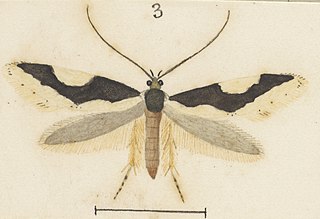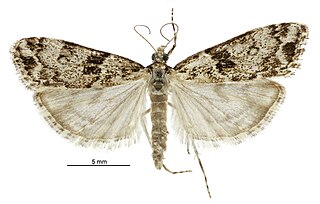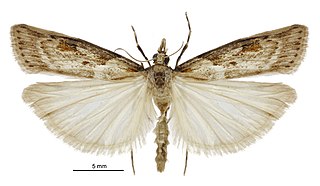
Bascantis is a genus of moths belonging to the family Tineidae. It contains only one species, Bascantis sirenica, that is endemic to New Zealand. This species is classified as "Data Deficient" by the Department of Conservation.

Eugennaea is a genus of moths belonging to the family Tineidae. It was described in 1914 by Edward Meyrick. The genus contains only one species, Eugennaea laquearia, which is endemic to New Zealand. Meyrick described the species from specimens collected by George Vernon Hudson on Nikau stems at Kaeo in January.

Habrophila is a genus of moths belonging to the family Tineidae. This genus was described by Edward Meyrick in 1889. It consists of only one species, Habrophila compseuta, which is endemic to New Zealand.

Thallostoma is a genus of moths belonging to the family Tineidae. It contains only one species, Thallostoma eurygrapha, which is endemic to New Zealand.

Izatha caustopa is a lichen tuft moth in the family Oecophoridae. It is endemic to New Zealand, where it is known very locally, and very infrequently, from the southern half of the North Island: two specimens collected in 2016 were the first seen for 30 years. It is classified as "Data Deficient" by the Department of Conservation.

Heterocrossa iophaea is a species of moth in the family Carposinidae. It is endemic to New Zealand.

Phycomorpha metachrysa, the milktree fruit moth, is a species of moth in the Copromorphidae family. It is endemic to New Zealand and has been found in the North and South Islands. The larvae feed on the fruit of species in the genus Streblus including Streblus heterophyllus. This adults of this species is on the wing from October to April.

Archyala pentazyga is a species of moth in the family Tineidae. It was described by Edward Meyrick in 1915 using a specimen provided by George Vernon Hudson. Hudson collected the specimen at Days Bay in Wellington in January. It is endemic to New Zealand.

Eudonia oreas is a moth in the family Crambidae. It was named by Edward Meyrick in 1884. This species is endemic to New Zealand.

Eudonia philetaera is a moth in the family Crambidae. It was named by Edward Meyrick in 1884. Meyrick gave a description of the adult moth in 1885. It is endemic to New Zealand.

Eudonia psammitis is a moth in the family Crambidae. It was named by Edward Meyrick in 1884. Meyrick gives a description of the species in 1885. It is endemic to New Zealand, including the Campbell Islands.

Eudonia cataxesta is a moth in the family Crambidae. It was described by Edward Meyrick in 1884. It is endemic to New Zealand.

Eudonia locularis is a moth in the family Crambidae. It was described by Edward Meyrick in 1912. This species is endemic to New Zealand.

Scoparia dryphactis is a moth in the family Crambidae. It was described by Edward Meyrick in 1911. This species is endemic to New Zealand.

Scoparia niphospora is a moth in the family Crambidae. It is endemic to New Zealand.

Crypsitricha roseata is a species of moth in the family Tineidae. It was described by Edward Meyrick in 1914. This species is endemic to New Zealand.

Prothinodes lutata is a species of moth in the family Tineidae. It was described by Edward Meyrick in 1914. This species is endemic to New Zealand.

Sagephora felix is a species of moth in the family Tineidae. It was described by Edward Meyrick in 1914. This species is endemic to New Zealand and can be found in the north half of the North Island. It inhabits native forest and adults of the species are on the wing from December to May, in July and November.

Tinea conferta is a species of moth in the family Tineidae. It was described by Edward Meyrick in 1914. However the placement of this species within the genus Tinea is in doubt. As a result, this species has been referred to as Tinea (s.l.) conferta. This species is endemic to New Zealand. This species has a pair of yellow marks near the dorsum with dark patches between these.

Hierodoris stella is a species of moth in the family Oecophoridae. This species is endemic to New Zealand and occurs in Auckland, Taranaki, Hawkes Bay, Bay of Plenty and Wellington. As at 2005 the larvae of this species is unknown as is its host plant. The adult moth frequents forest and are on the wing in January and February. It is classified as "At Risk, Relict'" by the Department of Conservation.




















